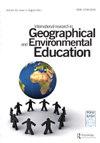IRGEE in retrospect – the 30th anniversary serving the international geography and environmental education communities
IF 3.1
Q2 EDUCATION & EDUCATIONAL RESEARCH
International Research in Geographical and Environmental Education
Pub Date : 2022-10-02
DOI:10.1080/10382046.2022.2140625
引用次数: 3
Abstract
Towards the end of the 1980s, John Lidstone and Rod Gerber shared a coffee at the relatively newly created Queensland University of Technology in Brisbane. As a new university, the pressure was on to increase international research publications, but for the two geographical educators, the options for publishing academic research papers were relatively few. Most of the reputable journals were strongly associated with national geographical societies, and often bridged the gap between professional teacher articles and academic research. Scarfe (1949) had reviewed research in geographical education, and recognised three types of study as predominating; tricks of the trade, psychological factors and the interests of children. Many of these were reports of small experiments conducted by teachers in their own classrooms. At that time, the “content” of geographical education was regarded as relatively fixed, and the purpose of the research was primarily to increase the speed and effectiveness of the learning process. The nexus between academic research and professional publications remained relatively close well into the 1980s. As Lidstone and Gerber reflected on the conferences and symposia of the IGU Commission on Geographical Education (CGE) at that time, it became apparent that the proceedings of such conferences constituted virtually the only truly international sources of academic research. This thought quickly led to the idea that the Commission was an ideal foundation on which to build a new journal with a focus on promoting the diffusion of high quality academic research across linguistic, cultural and national boundaries. Being the more junior academic, Lidstone was given the job of approaching international publishers with the proposal. At that time, there was an universal agreement amongst publishing houses that there was no demand for any new journals, much less one focussed on Geographical Education. However, after thirty-two (the number is forever imprinted in Lidstone’s brain) rejections, Latrobe University Press agreed to support the idea, so long as the cost for the first three years was underwritten by someone else. Gerber at that time was newly elected as President of the Royal Geographical Society of Queensland and proposed the new journal as an exciting new project for the Society, and thus the International Research in Geographical and Environmental Education (IRGEE) was born. Within a short time, Latrobe University Press sold its titles to Channel View Publications in the United Kingdom, who in turn sold its titles to Routledge—Taylor and Francis. In the early years, the editors’ primary objective was to increase circulation internationally and encourage young researchers around the world to make their work accessible around the world. Much effort was made to promote careful attention to carefully articulated and defined methodologies. When Joe Stoltman replaced Rod Gerber as co-editor, his extensive international networks (and those of Taylor and Francis) helped the journal to increase the geographical spread of both contributors and readers. When Lidstone and Stoltman passed the editorial baton to Gillian Kidman and Chew Hung Chang in 2017, the challenge had become one of increasing the journal’s “High Impact Metrics” status in response to governments’ desire to hold universities accountable to national policy initiatives.IRGEE回顾——为国际地理和环境教育界服务30周年
20世纪80年代末,约翰·利德斯通(John Lidstone)和罗德·格伯(Rod Gerber)在布里斯班相对较新成立的昆士兰科技大学(Queensland University of Technology)喝了一杯咖啡。作为一所新大学,增加国际研究出版物的压力很大,但对于这两位地理教育工作者来说,发表学术研究论文的选择相对较少。大多数声誉良好的期刊都与国家地理学会有着密切的联系,经常弥合专业教师文章和学术研究之间的差距。Scarfe(1949)回顾了地理教育的研究,认为三种类型的研究占主导地位;交易技巧、心理因素和孩子的兴趣。其中许多是教师在自己的教室里进行的小型实验报告。当时,地理教育的“内容”被认为是相对固定的,研究的目的主要是提高学习过程的速度和有效性。直到20世纪80年代,学术研究和专业出版物之间的联系仍然相对紧密。Lidstone和Gerber回顾了当时IGU地理教育委员会(CGE)的会议和专题讨论会,很明显,这些会议的记录实际上是唯一真正的国际学术研究来源。这一想法很快产生了这样一种想法,即委员会是建立一份新期刊的理想基础,其重点是促进高质量学术研究跨越语言、文化和国家边界的传播。作为一名资历较浅的学者,利德斯通被指派向国际出版商提出建议。当时,出版社之间普遍认为,对任何新期刊都没有需求,更不用说专注于地理教育的期刊了。然而,在32次(这个数字永远印在利德斯通的脑海中)拒绝后,拉特罗布大学出版社同意支持这一想法,只要前三年的费用由其他人承担。当时的格贝尔刚刚当选为昆士兰皇家地理学会主席,并提出将新期刊作为该学会令人兴奋的新项目,从而诞生了国际地理与环境教育研究(IRGEE)。在很短的时间内,拉特罗布大学出版社将其图书卖给了英国的Channel View Publications,后者又将其图书出售给了Routledge-Taylor和Francis。早年,编辑们的主要目标是增加国际发行量,鼓励世界各地的年轻研究人员让他们的作品在世界各地传播。为促进对精心阐述和界定的方法的认真关注作出了很大努力。乔·斯托特曼(Joe Stoltman)取代罗德·格贝尔(Rod Gerber)担任联合编辑时,他广泛的国际网络(以及泰勒和弗朗西斯的网络)帮助该杂志增加了撰稿人和读者的地理分布。2017年,当Lidstone和Stoltman将编辑接力棒交给Gillian Kidman和Chew Hung Chang时,挑战已经变成了提高该杂志“高影响力指标”的地位,以回应政府要求大学对国家政策举措负责的愿望。
本文章由计算机程序翻译,如有差异,请以英文原文为准。
求助全文
约1分钟内获得全文
求助全文
来源期刊

International Research in Geographical and Environmental Education
EDUCATION & EDUCATIONAL RESEARCH-
CiteScore
5.20
自引率
33.30%
发文量
11
期刊介绍:
International Research in Geographical & Environmental Education publishes quality research studies within the context of geographical and environmental education. The journal endeavours to promote international interest and dissemination of research in the field, provides a forum for critique, and demonstrates the relevance of research studies to good professional practice.
 求助内容:
求助内容: 应助结果提醒方式:
应助结果提醒方式:


